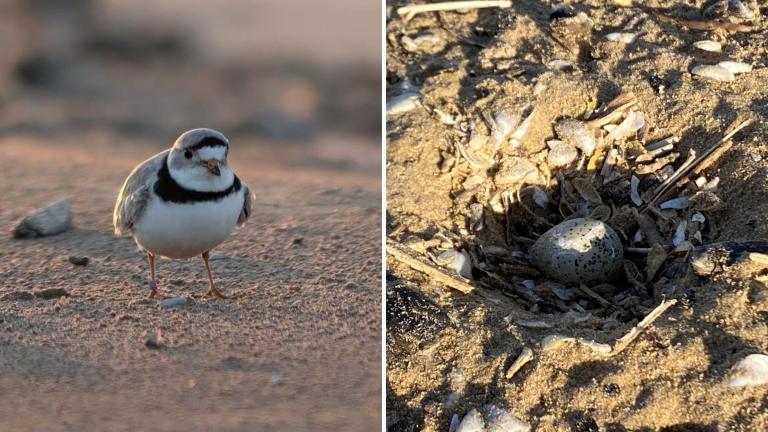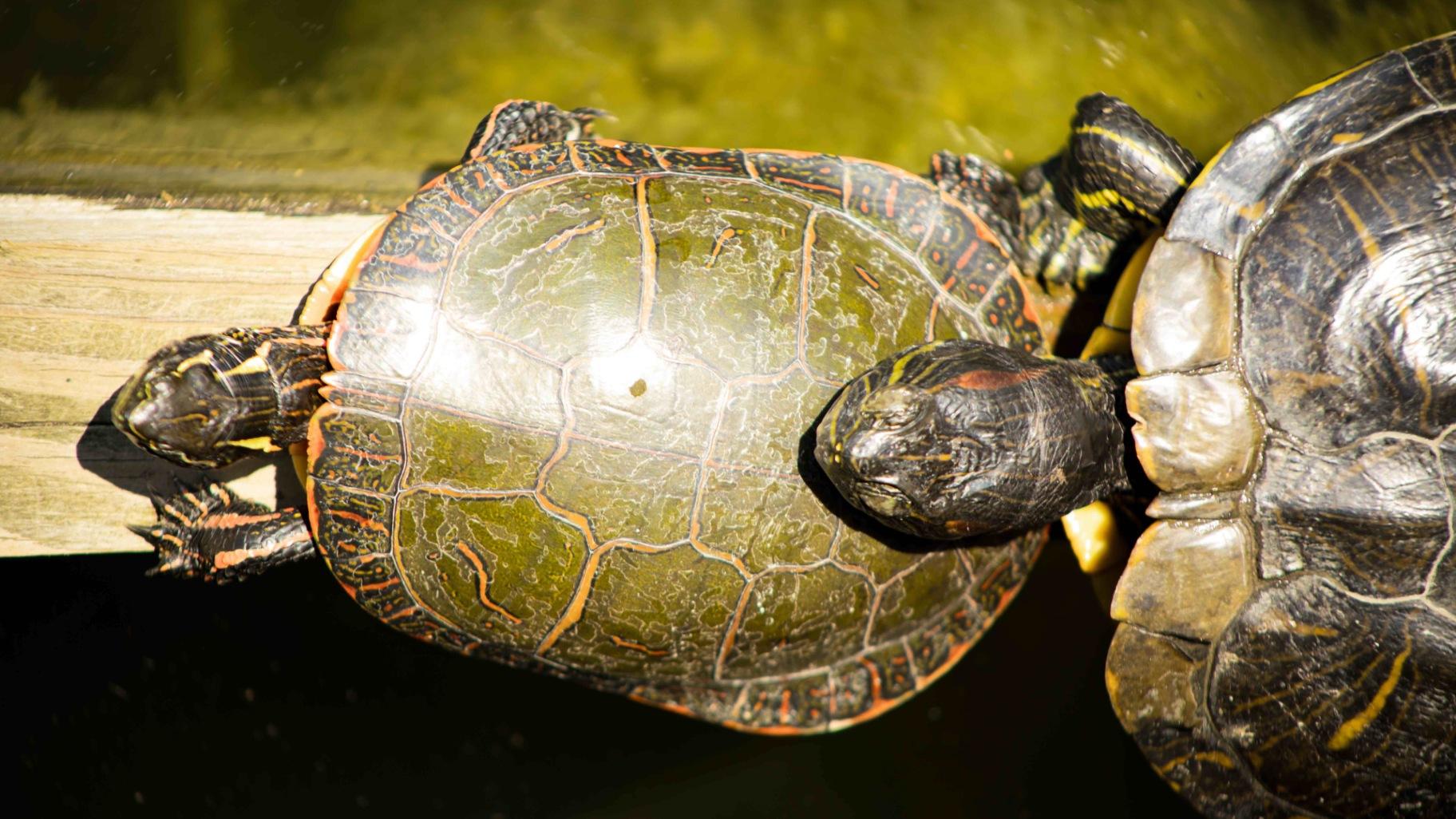 Turtles basking at a Lincoln Park pond. (Michael Izquierdo / WTTW News)
Turtles basking at a Lincoln Park pond. (Michael Izquierdo / WTTW News)
It’s been a year since Chicagoans fell in love with a burly snapping turtle nicknamed Chonkosaurus and woke up to the reptile’s presence in the city’s namesake waterway.
Well, the social media frenzy may have evaporated faster than you can say “rat hole,” but turtles haven’t gone anywhere.
So in honor of May 23 as World Turtle Day — a fake holiday to be sure, but a good cause nonetheless — let’s take a closer look at the many species that make their home in northern Illinois.
Who’s here?
There are more than 250 species of turtles worldwide, and roughly a dozen of them can be found in the northern part of the state. Snapping and painted turtles are among the most common, along with map turtles, musk turtles and pond sliders. Rarer species include box, Blanding’s and spotted turtles, along with some soft shell turtles.
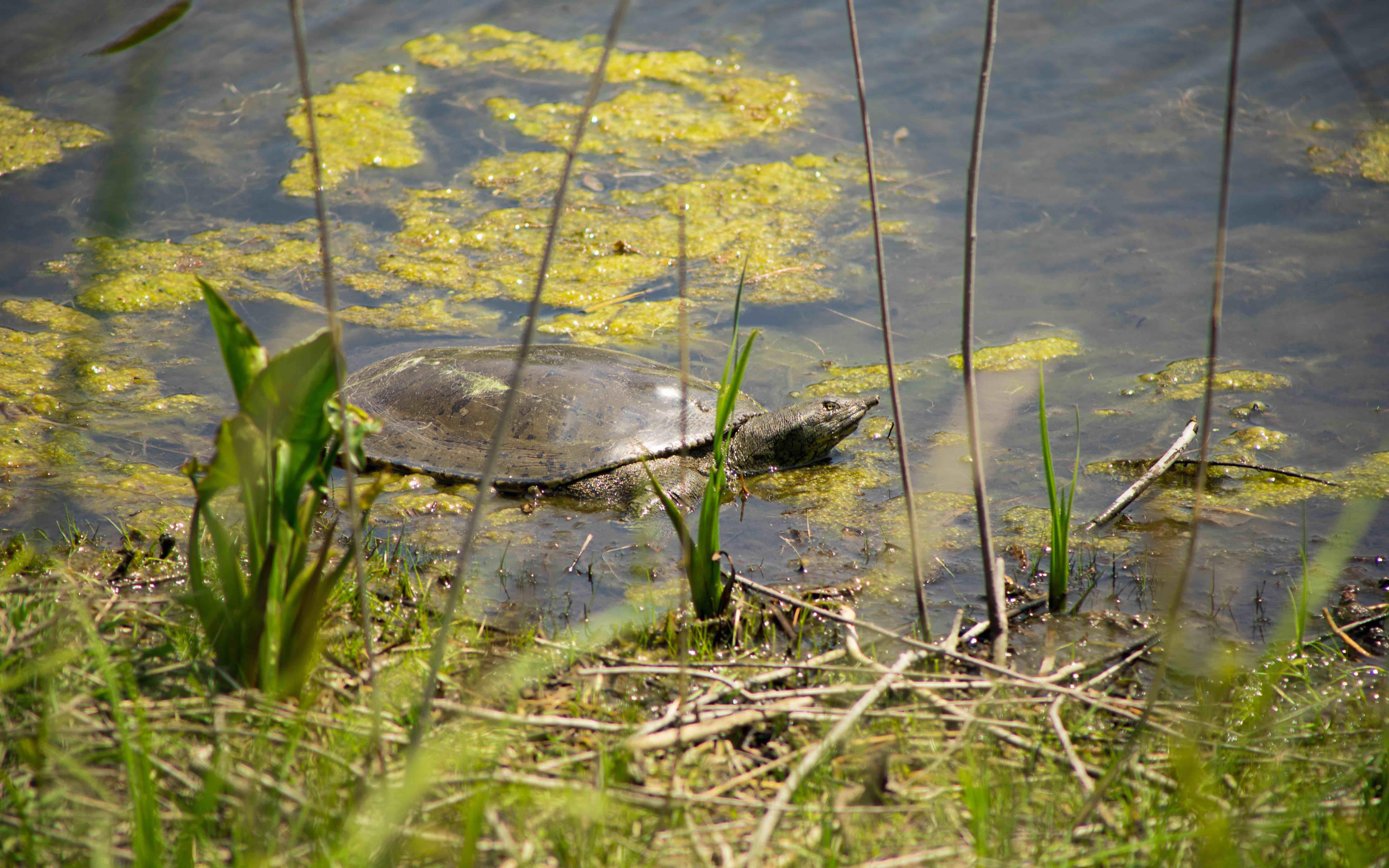 A soft shell turtle in Lincoln Park. (Michael Izquierdo / WTTW News)
A soft shell turtle in Lincoln Park. (Michael Izquierdo / WTTW News)
How can you tell them apart?
There’s actually quite a bit of variation among species, ranging from subtle differences in the shape of their shells to significant disparities in size.
Spotted turtles, for example, have yellow dots on their shells (hence the name), while the shells of ornate box turtles feature intricate patterns and unique colorations, said Becky Blankenship, a wildlife ecologist with the Forest Preserve District of Will County.
Painted turtles have yellow stripes on their heads, where pond sliders have a red stripe behind each eye.
Snapping turtles can bulk up to 35 pounds and have a long sawtooth tail. On the other end of the spectrum, there’s the tiny eastern musk turtle, one of the smallest species, measuring just 2 to 5 inches when fully grown.
And then there are the spiny soft shells, often described as “pancakes with legs,” also notable for their long snorkel faces.
“There’s just so many different adaptations,” said Tiffany Adams, senior aquarist at the Shedd Aquarium. “You’re constantly learning something new about them. I just think they’re cool animals.”
Where are they?
“It depends on what species we’re talking about,” said Anna Kase, a researcher at Lincoln Park Zoo’s Urban Wildlife Institute. “Painted and snapping turtles, if there’s water, they’ll be in it.”
Others are more particular about their habitat, she said.
Map turtles like flowing water and have shown a preference for the Illinois River, whereas the spiny soft shell favors still water.
Box turtles — the eastern and ornate — aren’t even aquatic, they’re terrestrial, though they occupy vastly different landscapes. Eastern box turtles like woodlands, and ornate make their home in sand prairies.
Where do they go in the winter?
In general, turtles more or less hibernate in the soft bottoms of rivers or ponds, burying themselves in the mud and slowing their metabolisms.
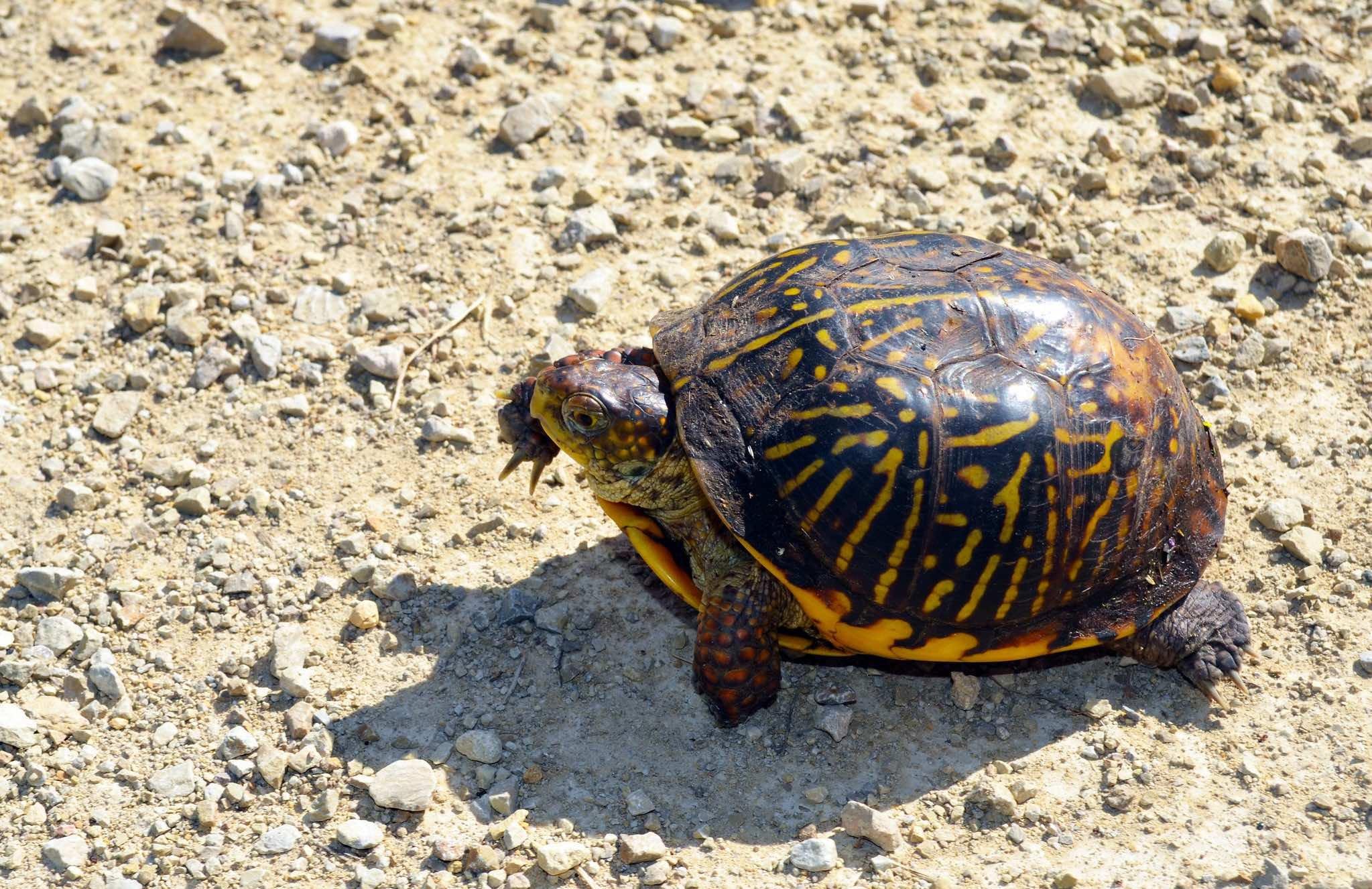 Ornate box turtles are doubly threatened by loss of habitat and illegal poaching. (Joanna Gilkeson / U.S. Fish and Wildlife Service Midwest Region)
Ornate box turtles are doubly threatened by loss of habitat and illegal poaching. (Joanna Gilkeson / U.S. Fish and Wildlife Service Midwest Region)
They don’t really need a home, right, because their shell is their “house”?
Actually, it’s their skeleton.
The top shell, called the “carapace,” is fused to the turtle’s backbone. Think of the bottom shell, or “plastron,” as its ribs. These two sections are connected by a bony bridge. For soft shell turtles, the carapace is covered in a leathery skin instead of hard scales.
Any cartoon that shows a turtle jumping out of its shell is patently wrong, Adams said.
“A turtle cannot leave its shell — it’s literally their bone structure,” she said.
In fact, most turtles tend to withdraw their heads and necks into their shells (snappers notably can’t). Some species, like box turtles, have hinged plastrons, allowing them to completely close on the carapace, providing more protection.
What do they do all day?
If aquatic, they’re moving around in the water column, spending a lot of time foraging for food. Many species are vegetarian, others are omnivores, and some, like snapping turtles, are carnivorous, feeding on snails, insect larvae and other meat including crayfish.
People are most likely to spot turtles when they come out of the water to bask, sunning themselves on logs, rocks or other structures. They do this because they’re cold-blooded, and basking is how they warm up and regulate their temperature, Adams said, plus they need the hit of vitamin D, same as humans.
They’re also drying out their shells to prevent fungus from forming, she said. “That can cause shell rot,” Adams explained, “and it will start to degrade.”
During the summer, turtles are likely to spend less time basking, because they can overheat, she said. “If it’s a hot day, they’re more likely to be in the water.”
Video: Turtles bask in the sun in the Chicago River. (Patty Wetli / WTTW News)
Is basking kind of like a social hour?
Not really, our experts said.
Turtles will share habitat and basking perches with other turtles, including from different species, but they’re fairly solitary.
The fact that a bunch of turtles might be hanging out on the same log — or concrete pedestal — is more a sign that it’s a great spot for basking, and as many of them are using it as can squeeze themselves onto the space.
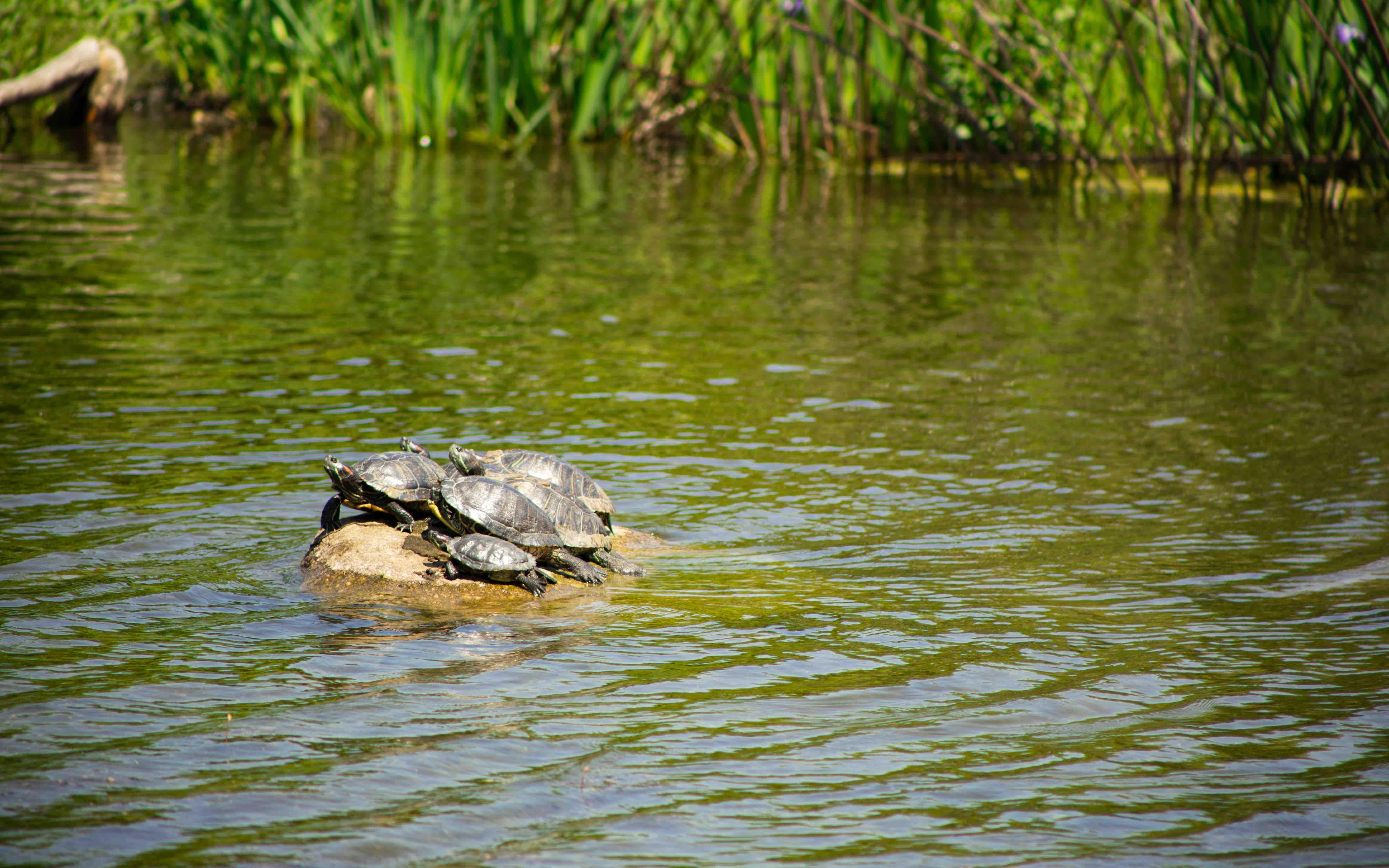 This might look like a family portrait, but it isn’t. (Michael Izquierdo / WTTW News)
This might look like a family portrait, but it isn’t. (Michael Izquierdo / WTTW News)
What about family groups?
If there are a dozen turtles on a single log and an observer notices some big ones and some littles ones, it would be wrong to interpret that as mommy and daddy turtles basking with their kiddos. That’s not how these creatures roll.
The smaller ones might indeed be juveniles, just not the offspring of the larger adults. Or they could be adult members of a smaller species.
In terms of parenthood, a male turtle’s job ends at fertilization and a female’s isn’t much more involved.
“The mom lays the eggs and says, ‘Good luck,’” said Kase.
In a female turtle’s defense, her journey to a nesting site is heroic enough, given that as she looks for a patch of appropriate land to dig a hole for her eggs — right around this time of the year — she has a high probability of getting run over by a car.
“Many turtle species are very long-lived,” Adams said. “Maybe there’s a road that wasn’t there when they were young, and they’ve crossed this area to go to their nesting site for many years, and now there’s a road there. They’re not adapted to that.”
Video: A good Samaritan helps a turtle cross bike path in Salt Creek Woods Nature Preserve. (Patty Wetli / WTTW News)
What other threats do turtles face besides humans in their cars?
Basically humans in general.
We’ve drained wetlands, plowed prairies, and channelized and dammed rivers, causing both habitat loss and degradation. Ornate box turtles, for example, are endangered in large part because their required habitat is almost nonexistent.
Toss in chemical pollutants and physical pollutants like fishing line — the latter of which is a much bigger deal than people might think, Kase said — and it’s a wonder turtles are persisting at all.
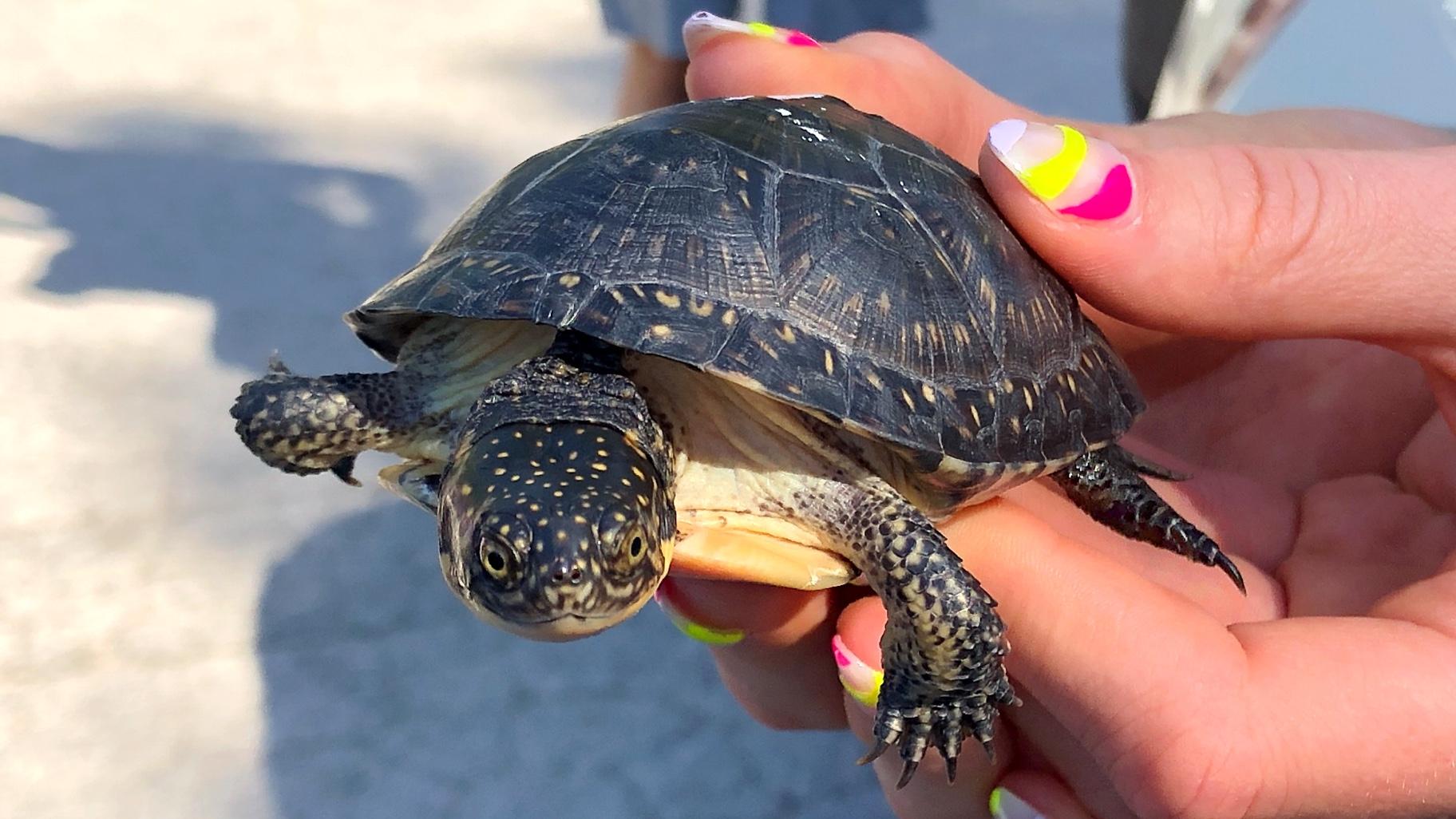 A Blanding’s juvenile turtle reared in a “head start” program and released into the wild. (Patty Wetli / WTTW News)
A Blanding’s juvenile turtle reared in a “head start” program and released into the wild. (Patty Wetli / WTTW News)
How can we help them?
Rescue efforts are underway to lend a hand to threatened species like the Blanding’s turtle, which suffers from a reproductive quirk: The turtles take an uncommonly long time to reach sexual maturity and lay comparatively fewer eggs than their more prolific counterparts.
Shedd Aquarium is partnering on a “head start” program that captive-rears Blanding’s juveniles until they’re large enough to be released into the wild with less risk of predation.
Blankenship is focused on boosting the ornate box turtle population, which is not only a victim of habitat loss but also of poaching.
“O’Hare finds a lot of turtles being smuggled,” she said. “It’s one of the things that stresses me out.”
To protect a population discovered in Will County in 2013, Blankenship tracks the female adults and places cages over nesting sites when eggs have been laid to prevent predation.
Hatching success is 100%, she said. Now her hope is to at some point begin seeing adults she hasn’t marked.
Land management practices, including curtailing prescribed burns when turtles are on the move, are also designed to give the ornates a shot at increasing their population.
There are a few ways members of the public can pitch in and help turtles:
— If you see a turtle in danger of being run over, get it to safety by moving it in the same direction it was traveling. (Then sanitize your hands.)
— Don’t release a pet turtle into the wild. Captive turtles can pick up fungal diseases from their tanks, and if that gets into a wild population, it can have devastating effects, Blankenship said.
Video: A turtle swims in a pond in Lincoln Park. (Patty Wetli / WTTW News)
Could we end on a fun note?
Sure thing. Here are some quirks about our Illinois species.
— That little eastern musk turtle has a powerful defense mechanism: Its nickname is “stinkpot,” owing to the odor it produces when captured.
— The northern map turtle is slow to hibernate in the winter, and you might see it walking around even after things have iced over.
— In several species, the female is almost twice the size of the male. During courtship, the fellows woo the ladies by swimming backward in front of her, dazzling her with their long front claws.
— Box turtle shells have growth rings like trees. You can count a turtle’s actual age up to a certain point, but then the growth becomes so minimal from one year to the next that the difference between rings is almost indiscernible, so experts tend to give up and just say “adult” turtle.
— Turtles have a reputation for being slow, but some species are quite powerful swimmers and they can skedaddle when they need to — watch them scuttle off a basking site when a human passes.
— Turtles breathe through their butts when they’re hibernating.
Contact Patty Wetli: @pattywetli | (773) 509-5623 | [email protected]


